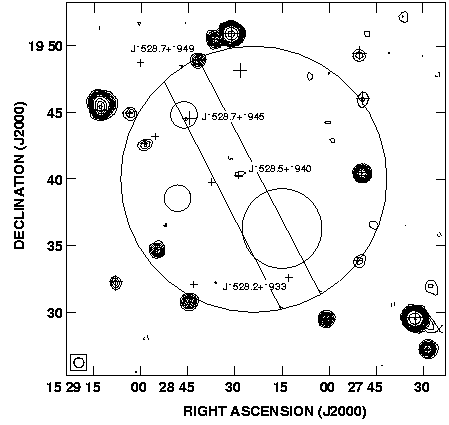
Gamma-ray Burst 970111

The BeppoSAX Gamma Ray Burst Monitor (GRBM) was triggered on Jan.
11. 9:44 UT. A Gamma Ray Burst was observed both with the GRBM and one
of the WFC. A follow-up observation centered on the accurate
position derived from WFC data has been performed less then 16 hours after
the burst.
 Previous IAU Circulars
Previous IAU Circulars
- IAUC
6533 Discovery with WFC onboard BeppoSAX
- IAUC
6539 2 X-ray sources in BeppoSAX pointing; 3 faint sources in ROSAT
All-Sky-Survey (1991)
- IAUC
6544 Optical photometry
- IAUC
6545 Radio source coincident with BeppoSAX source 'a'; Ulysses-BATSE
triangulation ring
- IAUC
6559 Spectroscopic ID of two galaxies within 1" of the radio source
- IAUC
6567 ROSAT HRI observations detects BeppoSAX source 'A', but not 'B'
- IAUC
6569 Revised WFC location and reduced error circle of GRB
- IAUC
6571 Reduced IPN triangulation arc; radio source inside new error
box detected at Westerbork
- IAUC
6574 BVI images of the refined error-box: no variable source brighter than
V = 19.
- IAUC
6598 Calar Alto observations: no fading optical object down to B=23 and
R=22.6 mag.
 Results of Observations
Results of Observations
- The BeppoSAX pointing on Jan. 12/13 reveals two sources A and B
(IAUC 6539) within the 10 arcmin GRB error box at positions
1SAX J1528.8+1944
1SAX J1528.8+1937.
The relative brightnesses of these sources in the
MECS and LECS images
reveal their different spectral hardness.
- Three very faint sources are found in the ROSAT All-Sky-Survey data
(taken Aug. 5-7, 1991). One of these sources coincides with the
BeppoSAX source B, while the BeppoSAX source A appears to be resolved
into two ROSAT sources.
- Positions and error radii of the various sources are overplotted
on the
digitized POSS image.
The large circle centered on the image represents the 10 arcmin error radius
of the GRB position detected with the BeppoSAX WFC (IAUC 6533). Circles A and
B correspond to the 1 arcmin error radii of the two sources detected in the
BeppoSAX MECS/LECS pointing on January 12/13, about 16 hours after the burst
(IAUC 6539).
The three small circles represent the 45 arcsec error radii of the faint
X-ray sources present in the ROSAT All-Sky survey data (see IAUC 6539).
- A. Connors (UNH) communicated for the COMPTEL team:
GRB 970111 occurred at 44 deg zenith angle of GRO, thus being in the
COMPTEL FOV. In quick-look imaging of COMPTEL data, no signal is seen at all.
In the COMPTEL telescope lightcurve there might be a slight peak at 1-2 s;
and another at about 45 s after trigger; but these are no more
significant than the peak about 20 s before the trigger.
- ROSAT HRI observation on January 16, 1997 for a total of 1305 sec.
Three sources are detected, one of which is inside the reduced GRB location
(IAUC 6545). This source RX J152845+1944.5 coincides with the BeppoSAX source
'A' (IAUC 6539), the radio source VLA J1528.7+1945 (IAUC 6545) and the two
galaxies (IAUC 6559). See the scetch below
for the relative locations of the various sources.

The large circle is the 10 arcmin GRB error box, 'A' and 'B' denote the
BeppoSAX sources detected during the pointings, the circles labeled 1-3
are the X-ray sources from the RASS (1991), and the squares denote the three
sources found in the HRI pointing on Jan. 16, 1997.
- Radio image (from D. Frail) showing the revised error box (IAUC 6569).
None of the X-ray or radio sources reported so far are within the new
error box!

- 1507.04081 from 16 Jul 15
S. Guiriec et al.: CGRO/BATSE Data Support the New Paradigm for GRB Prompt Emission and the New L$_i^nTh$-E$_peak^nTh$ L$_i^nTh$-E$_peak^rest$ L$_i^nTh$-E$_i^nTh$ L$_i^nTh$-E$_i^rest$ relation
The paradigm for GRB prompt emission is changing. Since early in the CGRO era, the empirical Band function has been considered a good
description of the keV-MeV spectra although its shape is very often inconsistent with the predictions of the pure synchrotron emission
scenarios. We have recently established a new observational model analyzing data of the NASA Fermi Gamma-ray Space Telescope. In this model,
GRB prompt emission is a combination of three main emission components: (i) a thermal-like component that we interpreted so far as the jet
photosphere emission, (ii) a non-thermal component that we interpreted so far as synchrotron radiation, and (iii) an additional non-thermal
(cutoff) power-law most likely of inverse Compton origin. In this article we reanalyze some of the bright GRBs observed with CGRO/BATSE with
the new model, namely GRBs 941017, 970111 and 990123. We conclude that BATSE data are fully consistent with the recent results obtained with
Fermi: some bright BATSE GRBs exhibit three separate components during the prompt phase with similar spectral parameters as these reported from
Fermi data. In addition, the analysis of the BATSE GRBs with the new model results in a relation between the time-resolved energy flux of the
non-thermal component and its corresponding $\nu$F$_\nu$ peak energy (i.e., F$_{i}^{nTh}$-E$_{peak,i}^{nTh}$) that has a similar index as the
one initially derived from Fermi data. For GRBs with known redshift (z) this results in a possible universal relation between the luminosity of
the non-thermal component and its corresponding $\nu$F$_\nu$ peak energy in the rest frame (i.e., L$_{i}^{nTh}$-E$_{peak,i}^{NT,rest}$). We
estimated z for GRBs 941017 and 970111 using GRB 990123--with z=1.61--as a reference. The estimated z for GRB 941017 is typical for long GRBs
and the estimated z for GRB 970111 is right in the range of the expected values for this burst.
Back to JG's
homepage
Jochen Greiner, last update: 16-Jul-2015
[Disclaimer]
![]() Previous IAU Circulars
Previous IAU Circulars 
